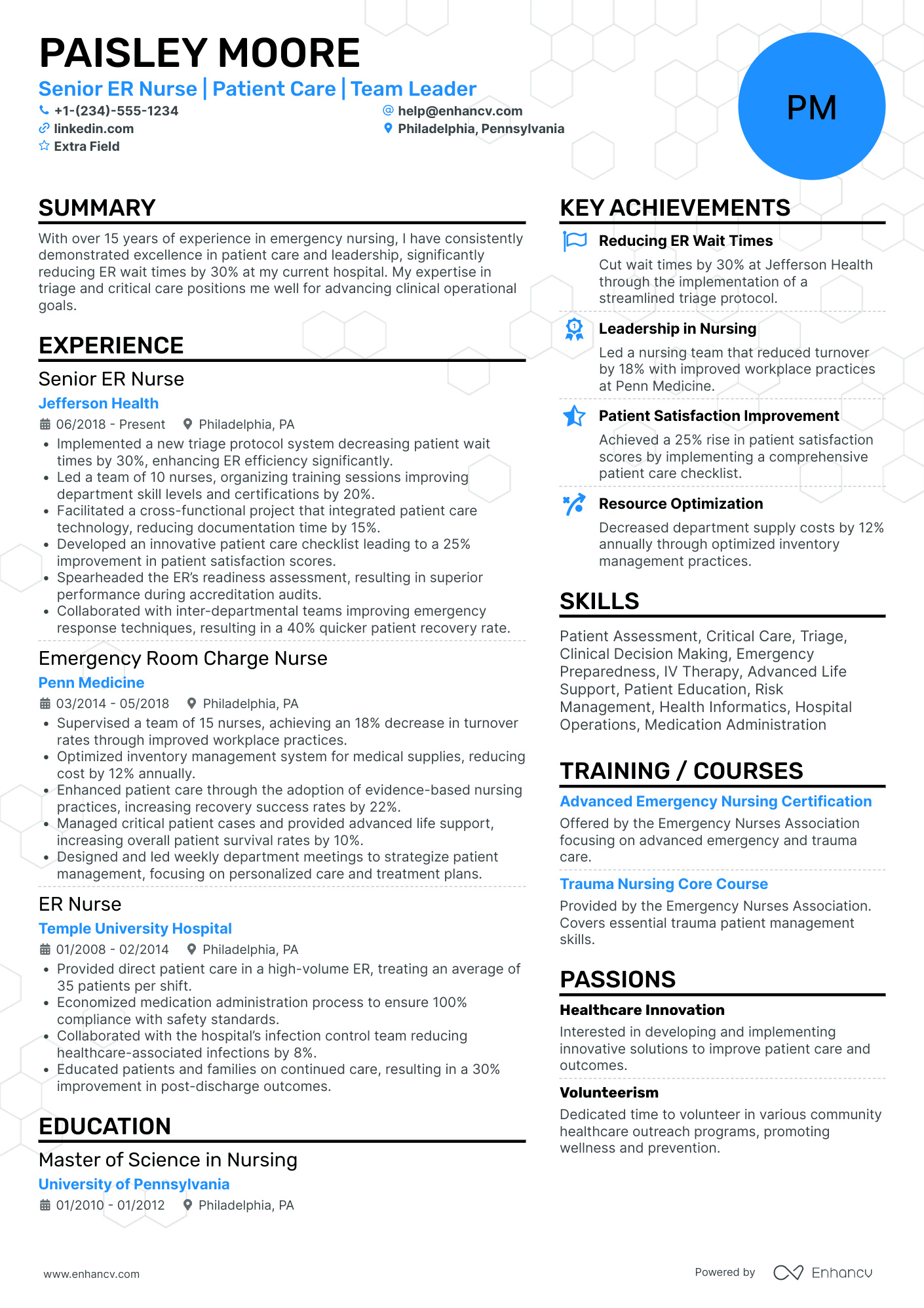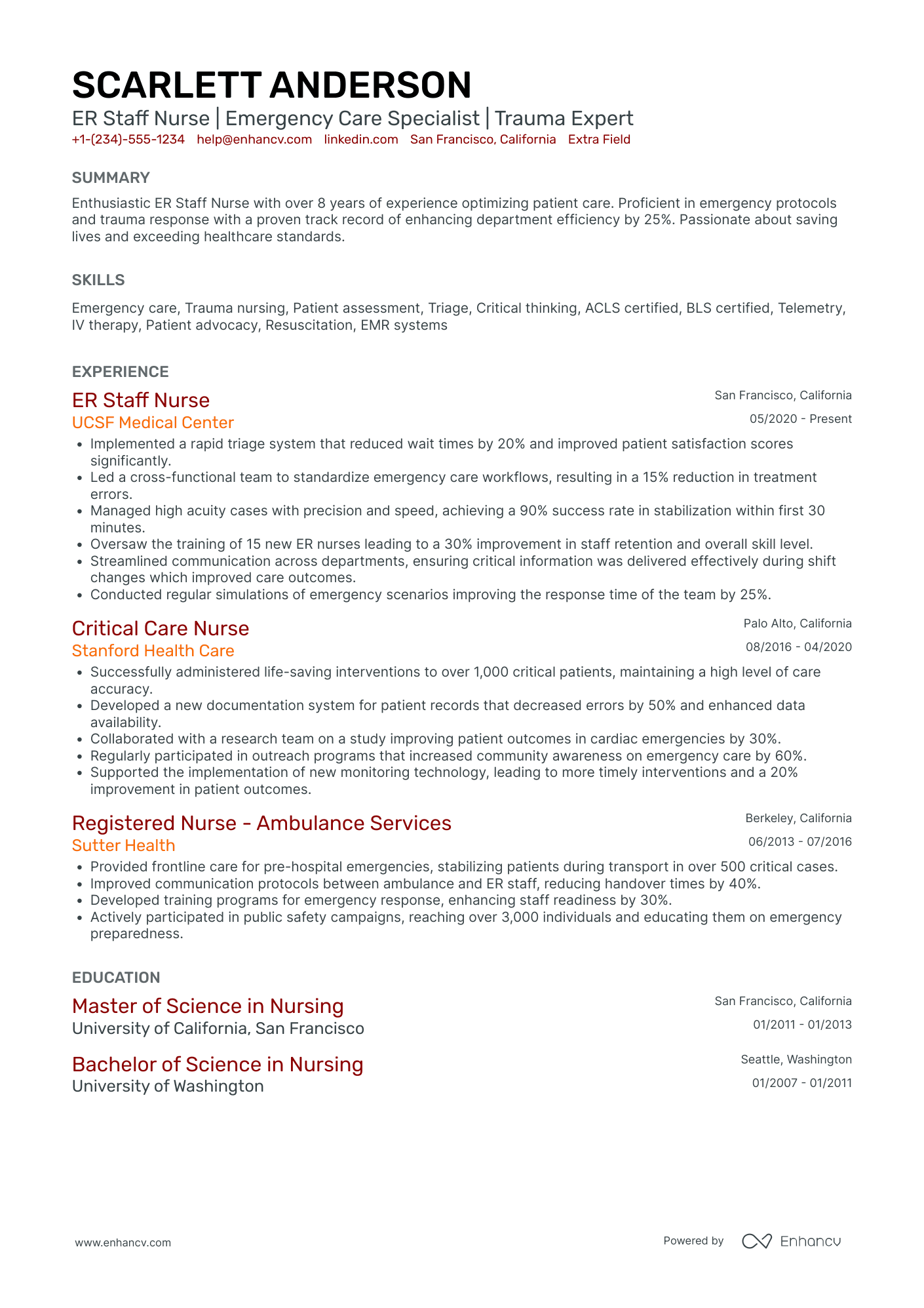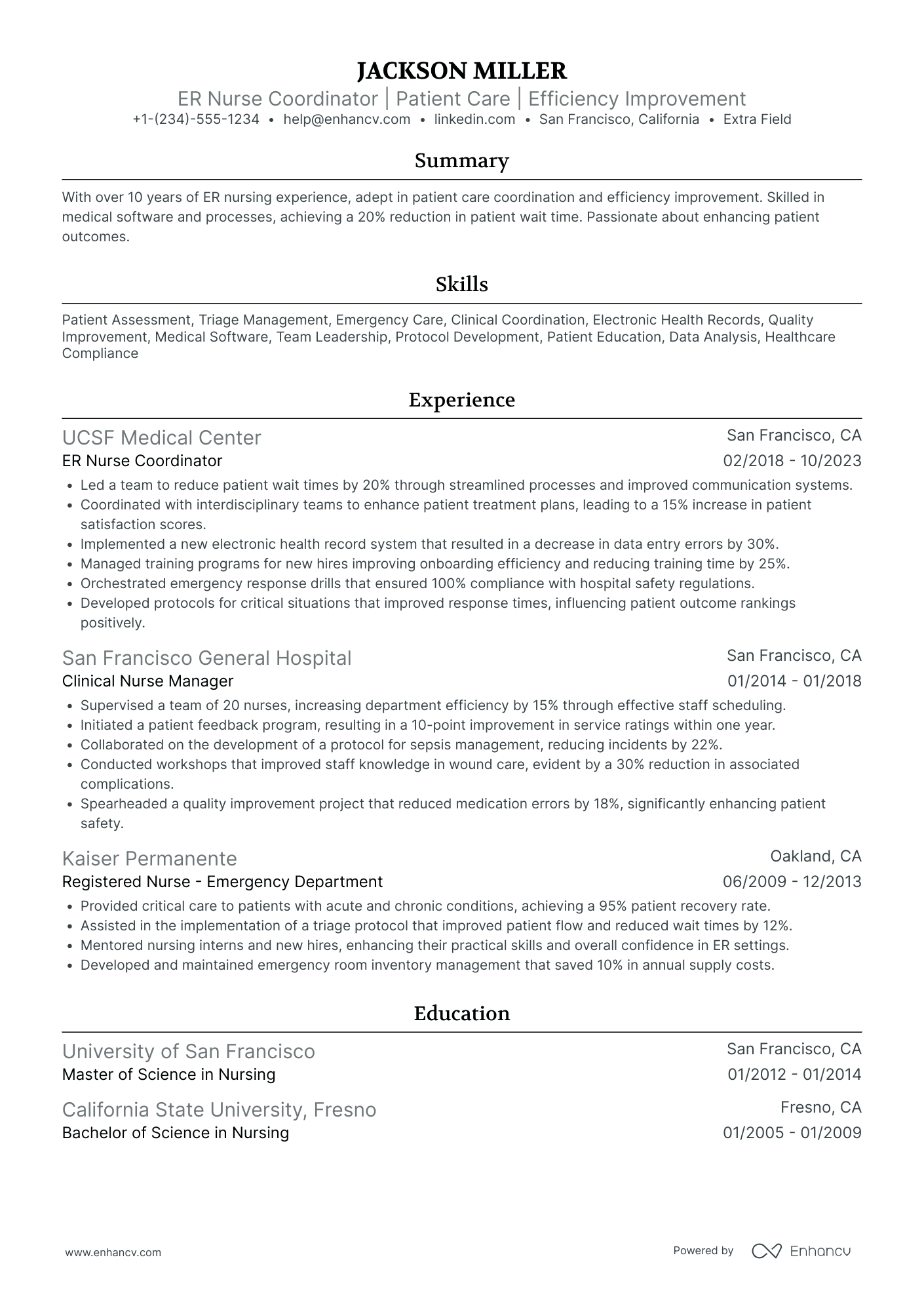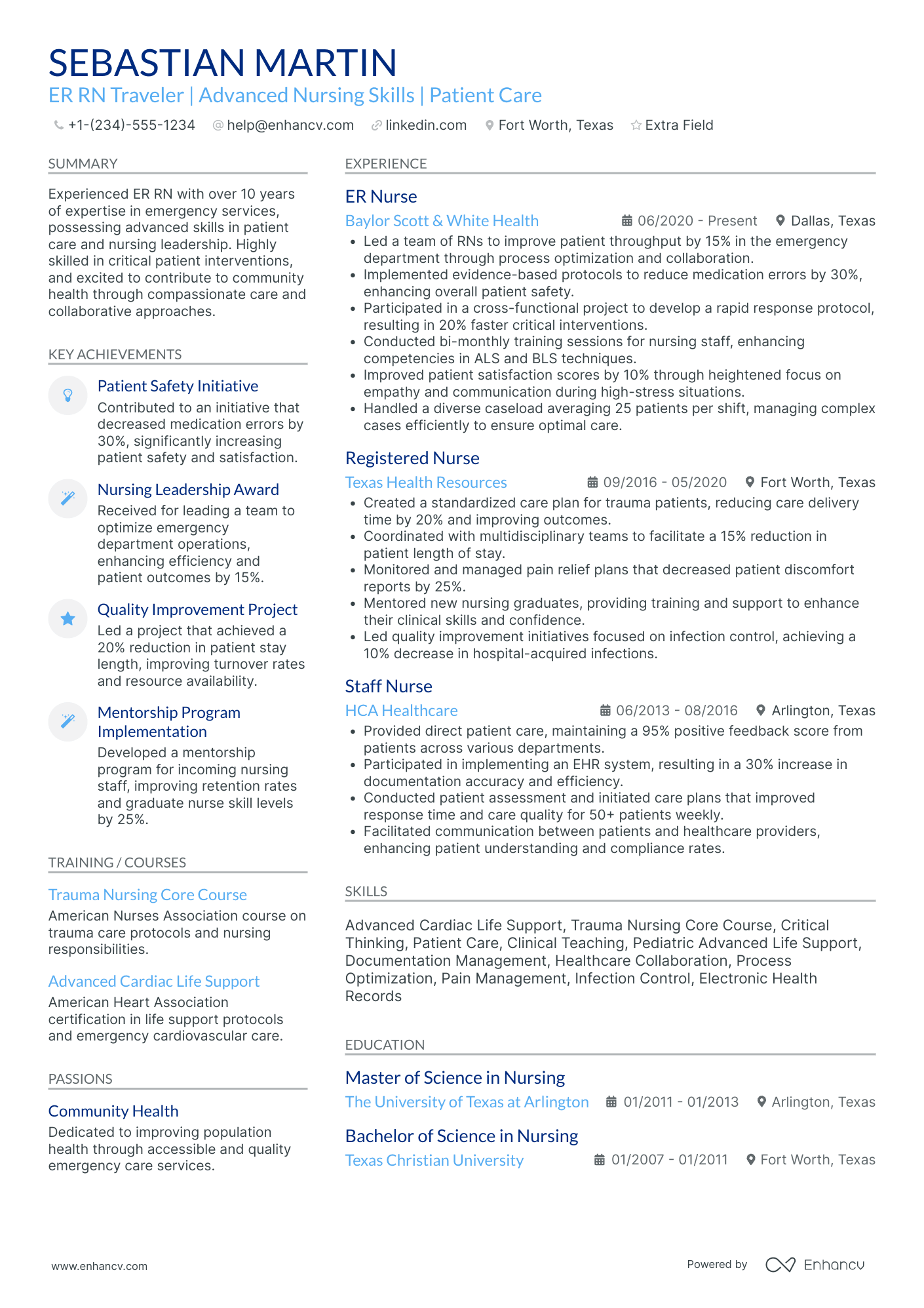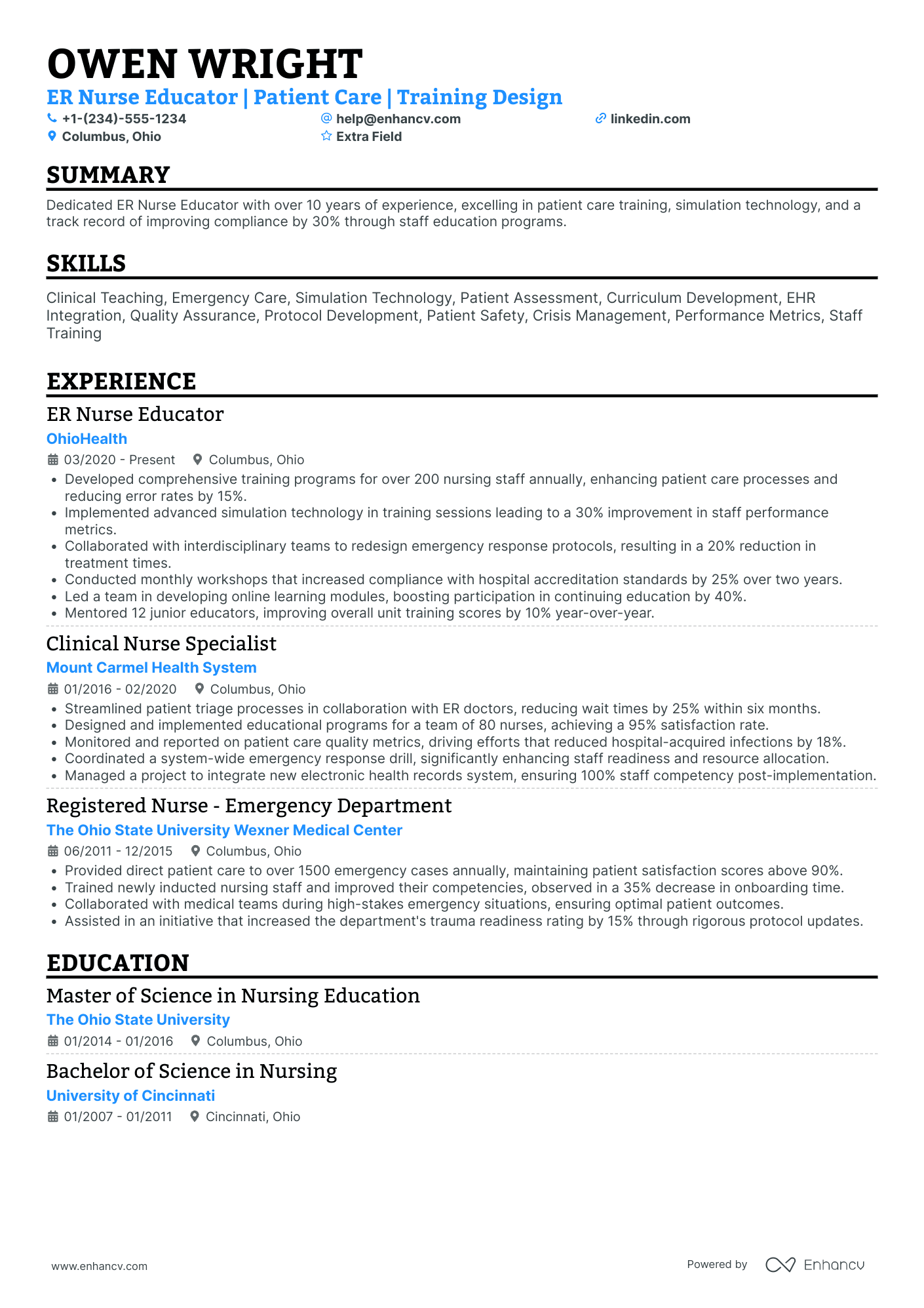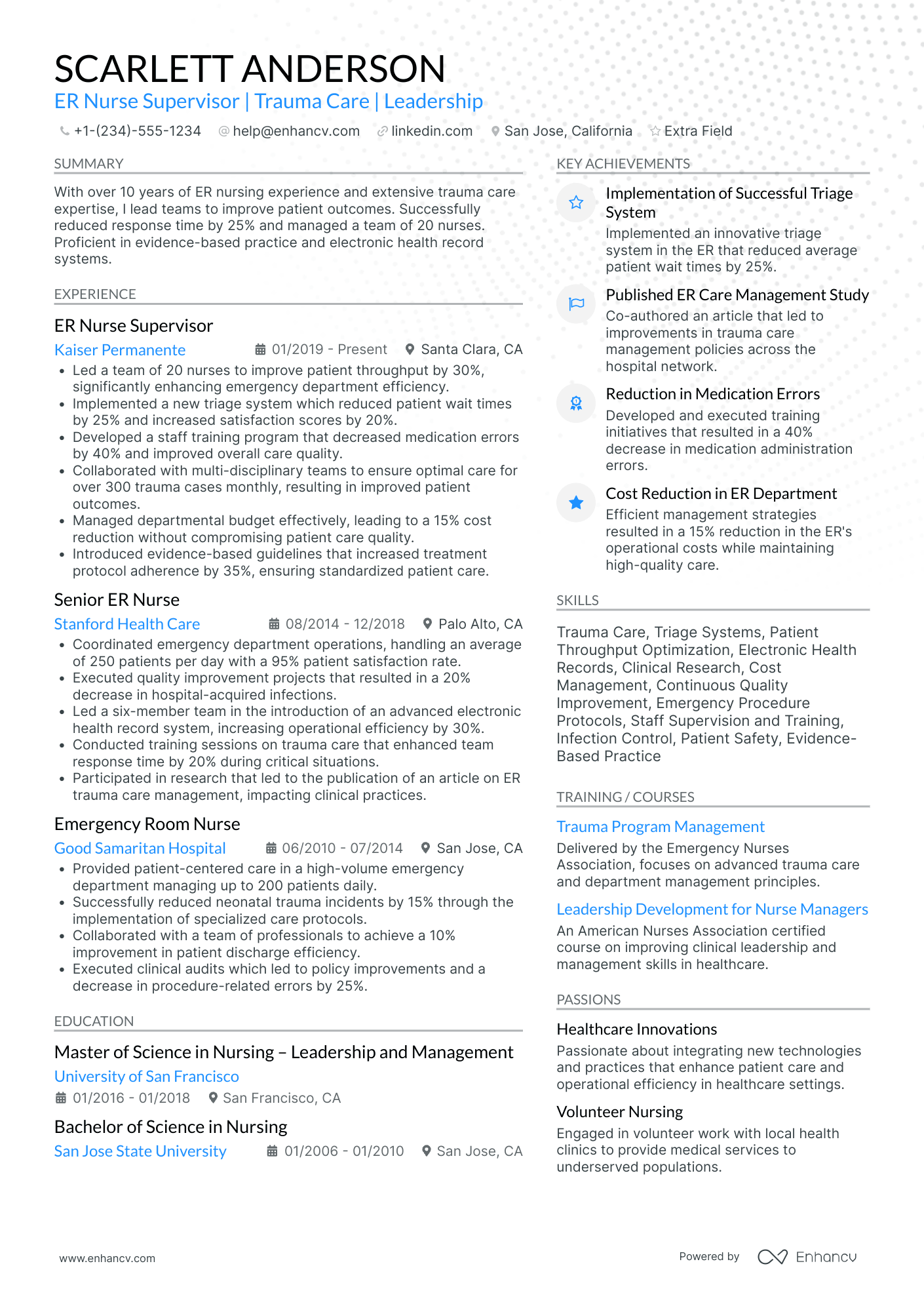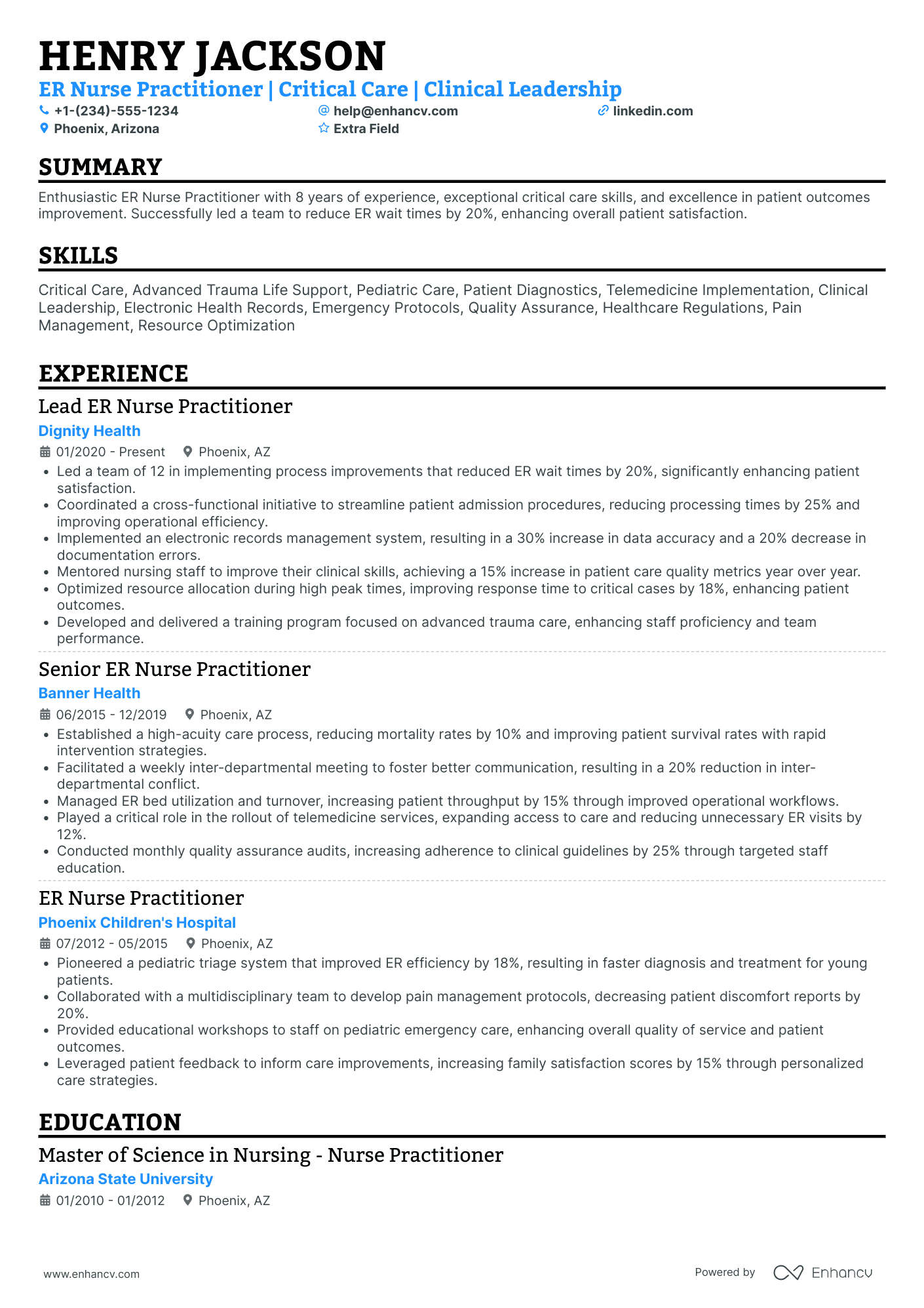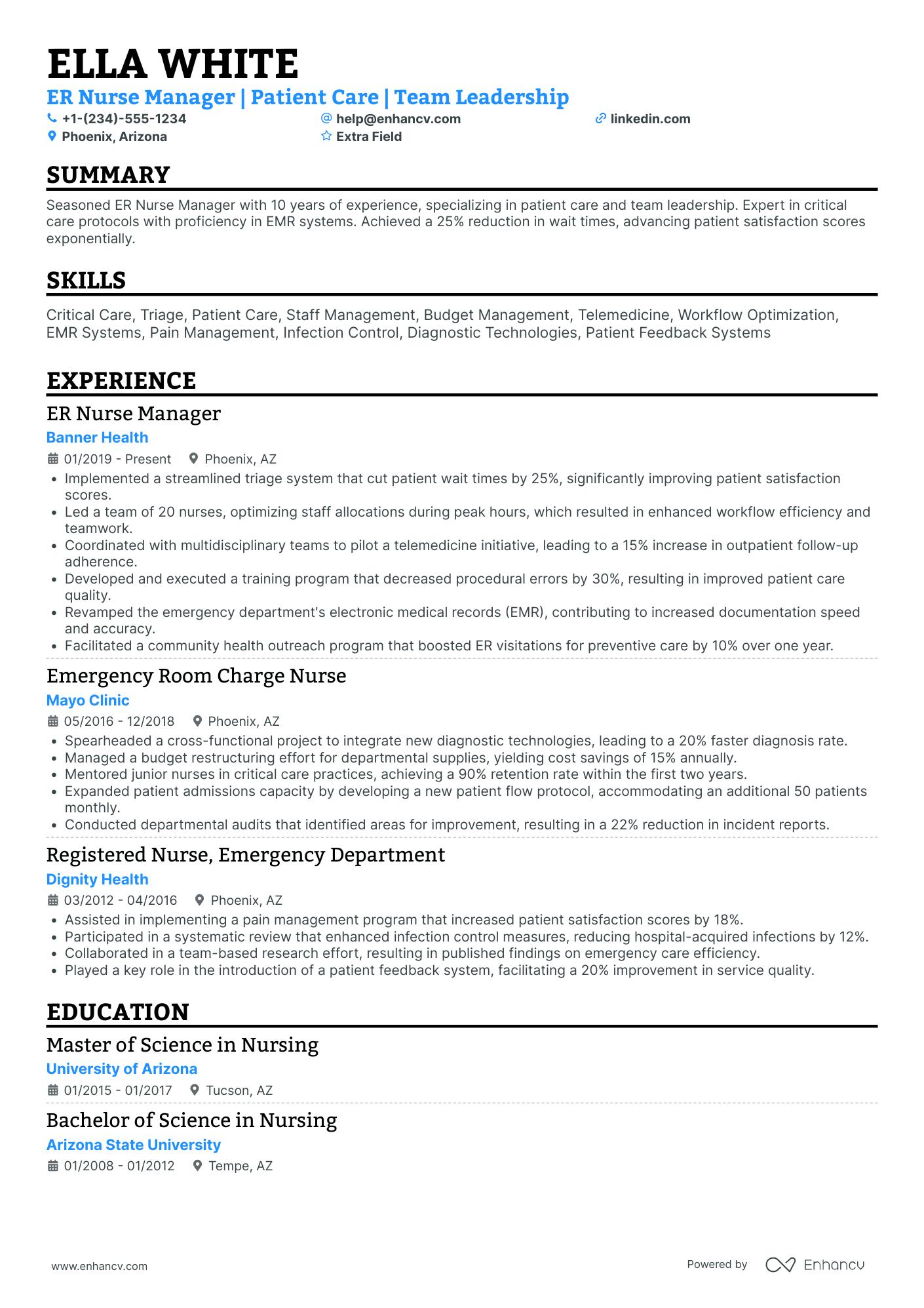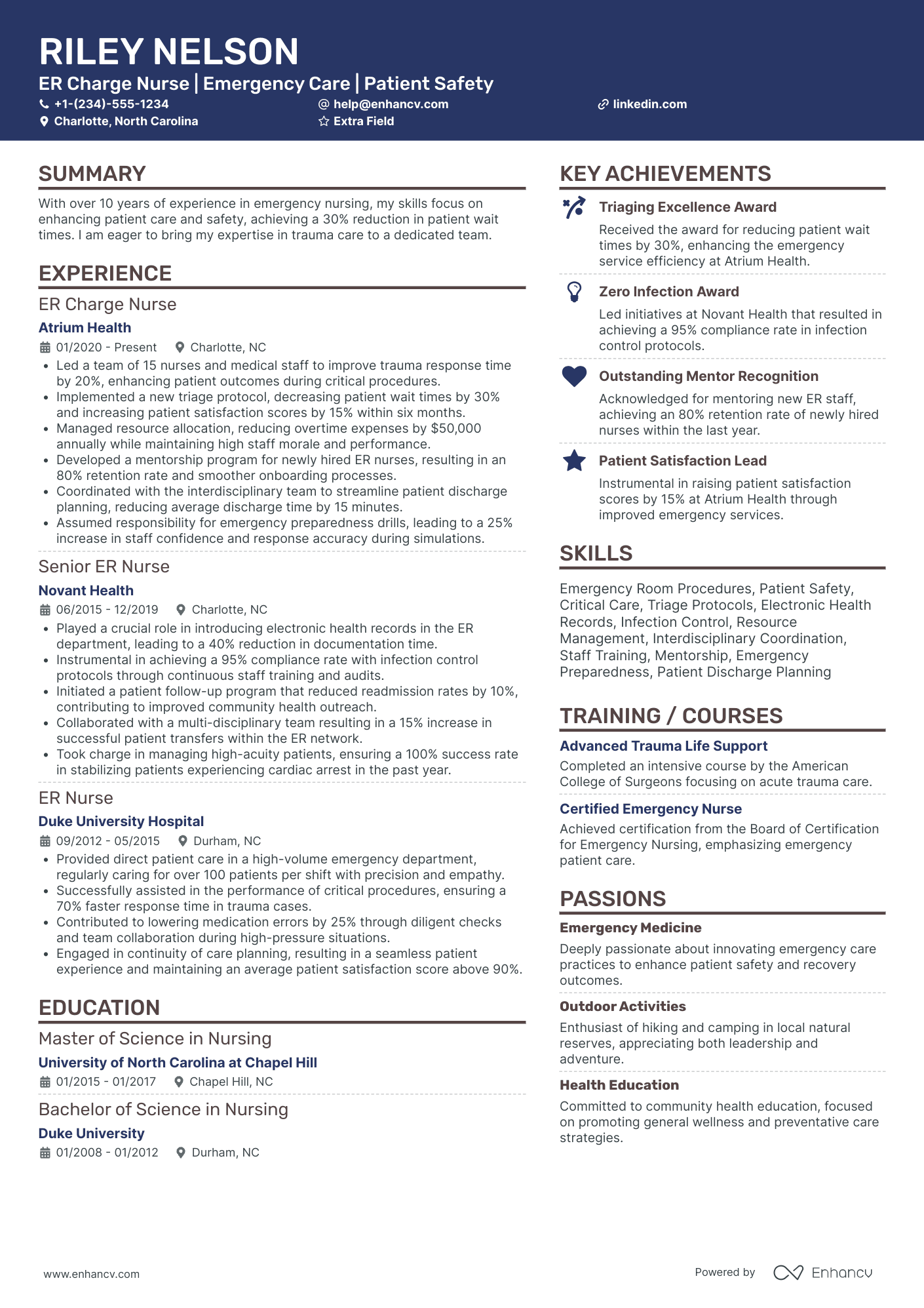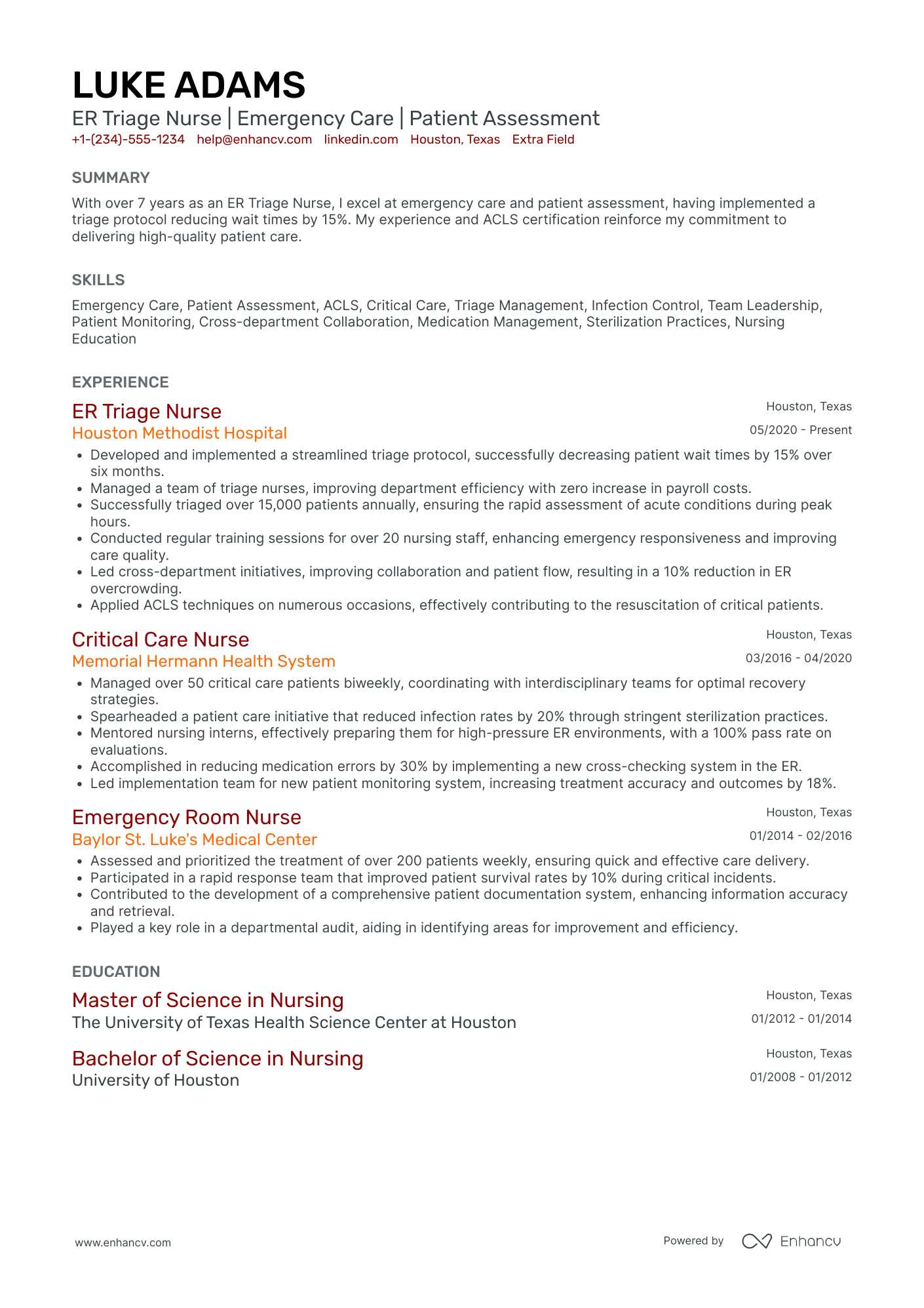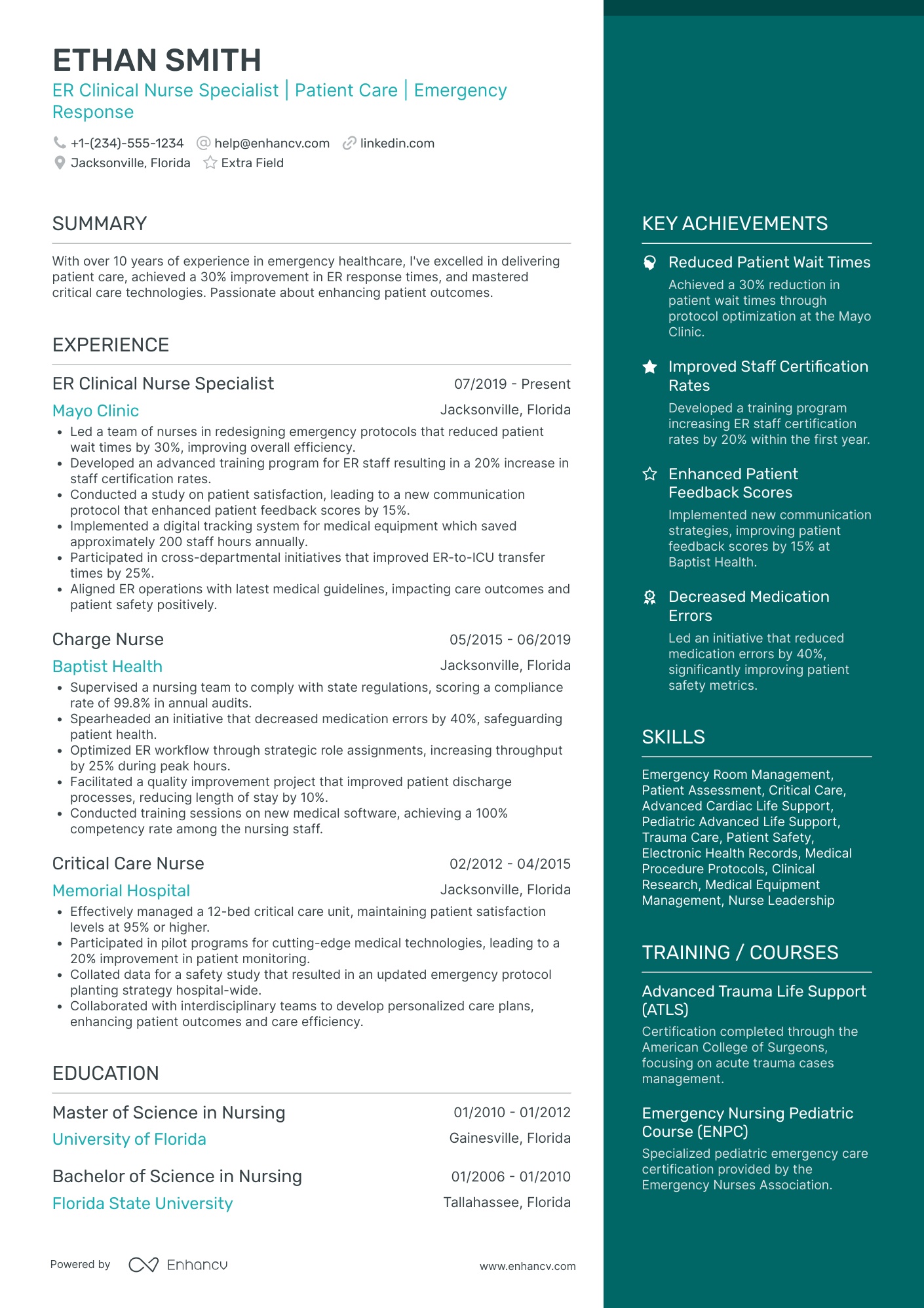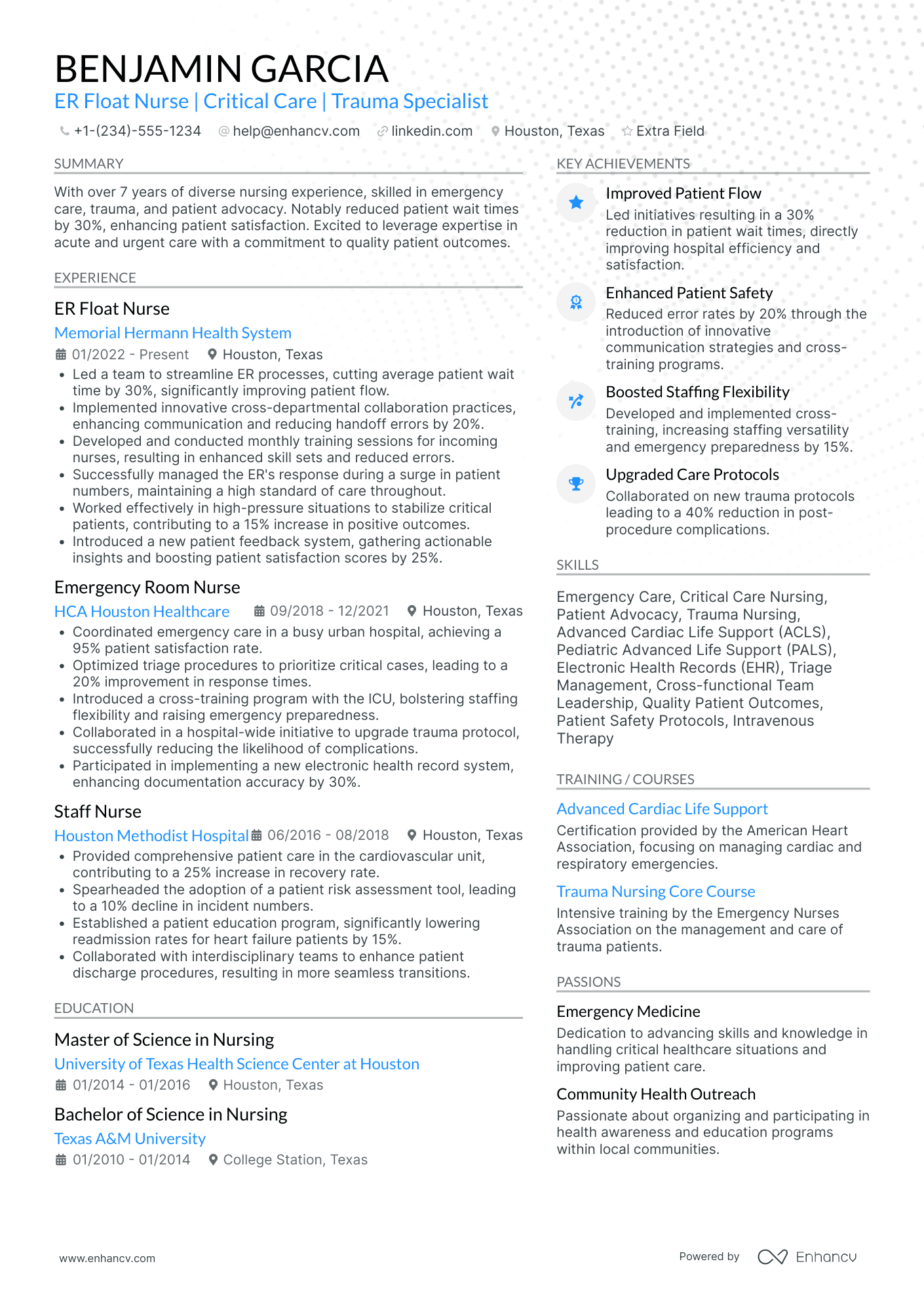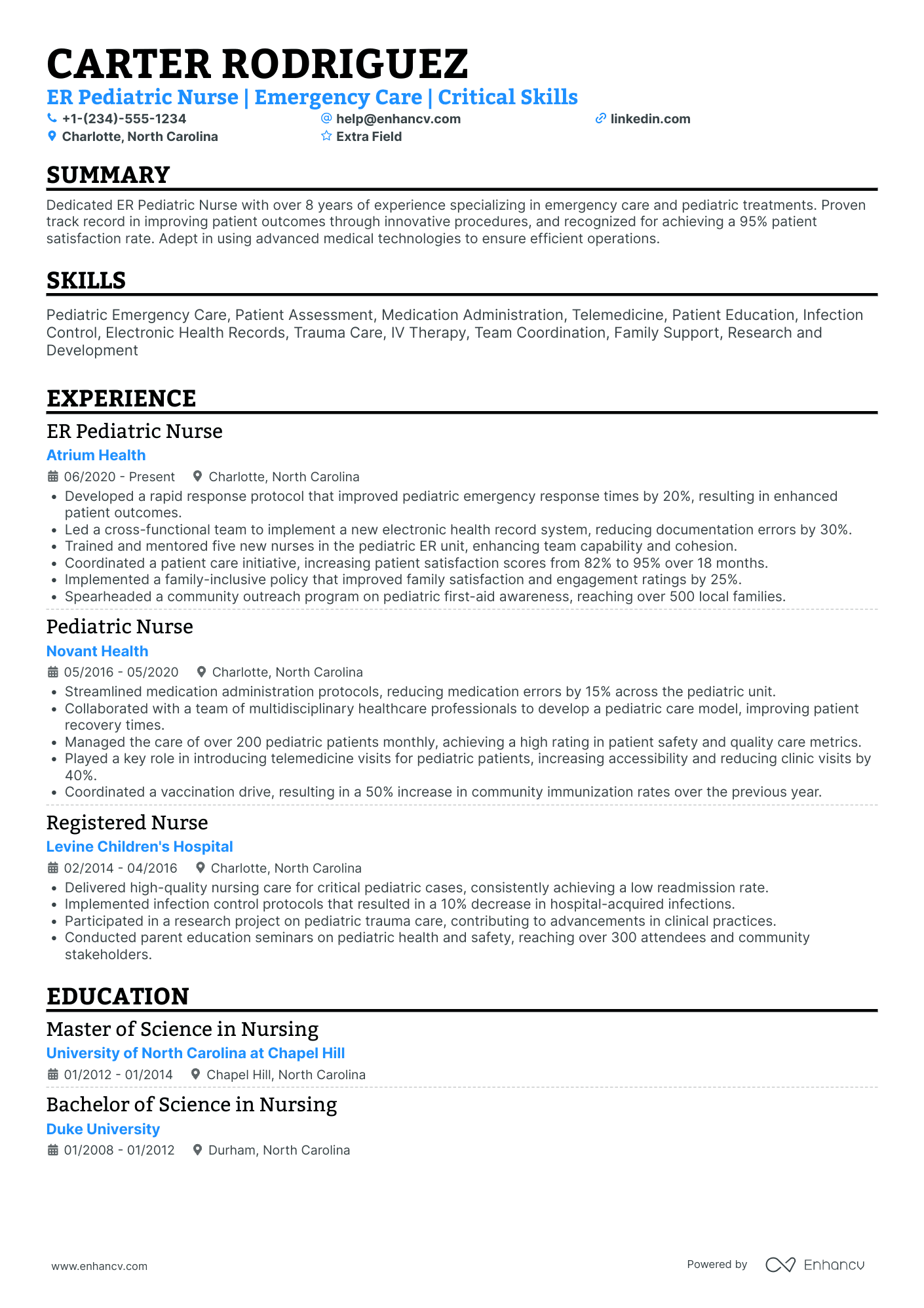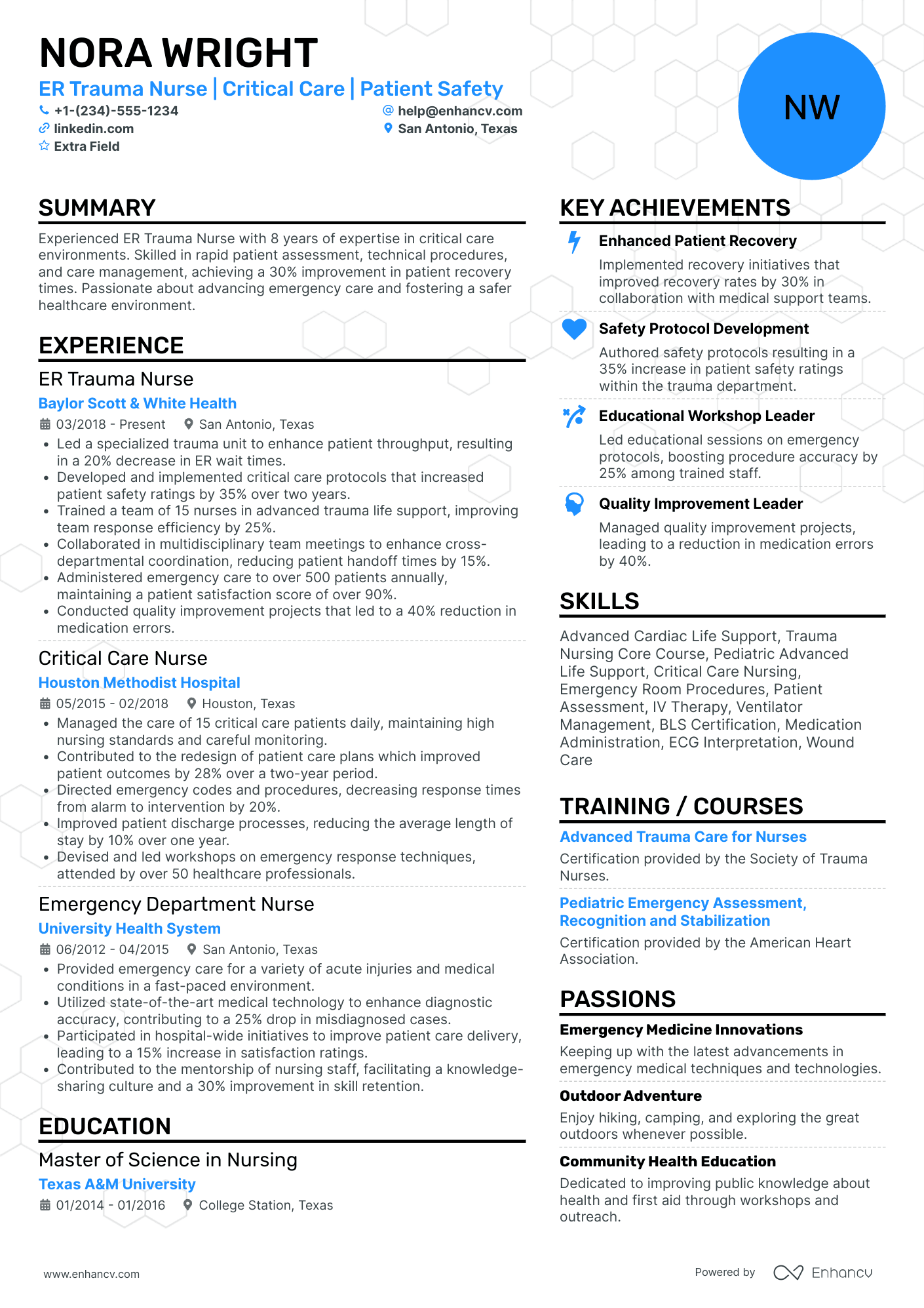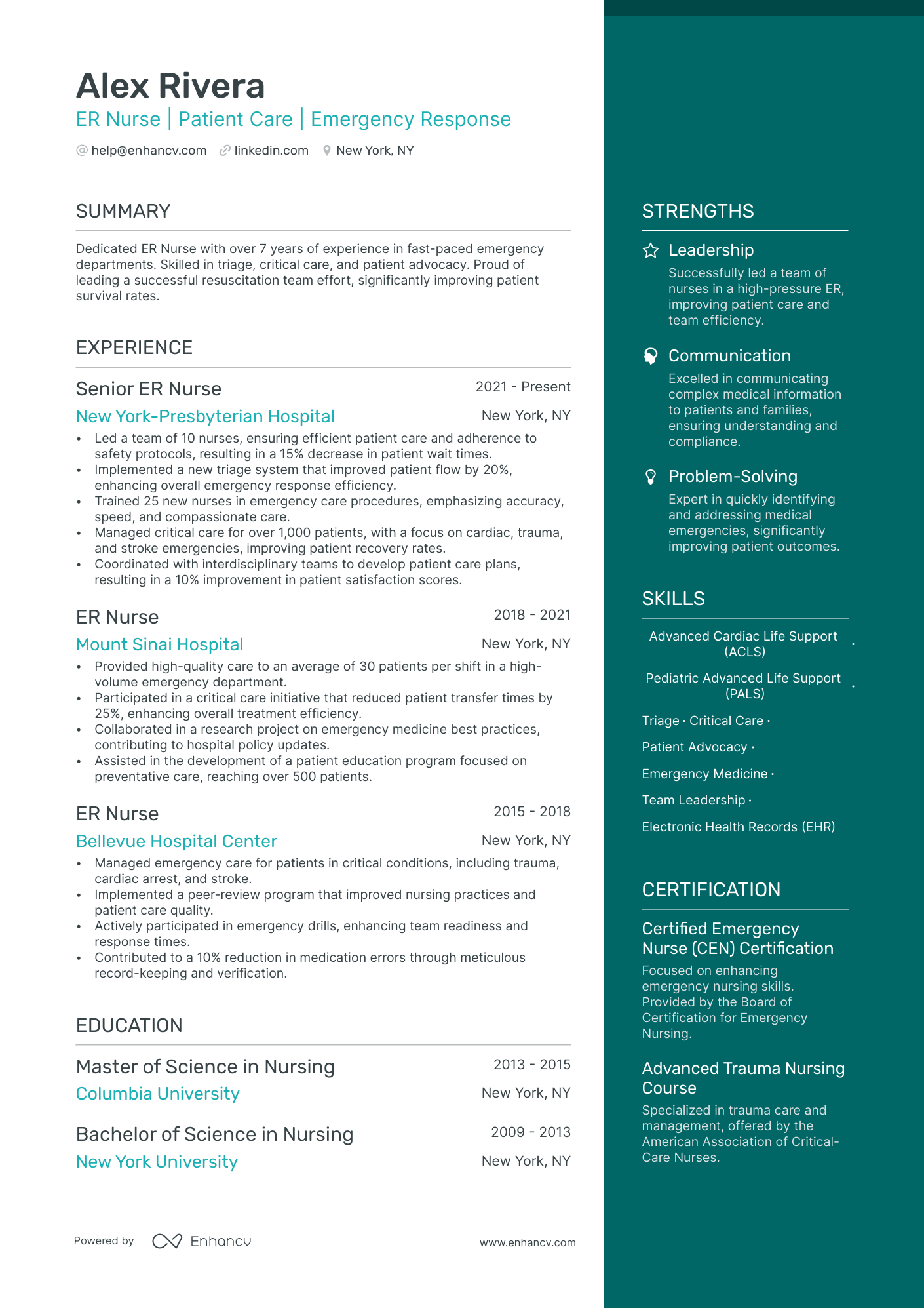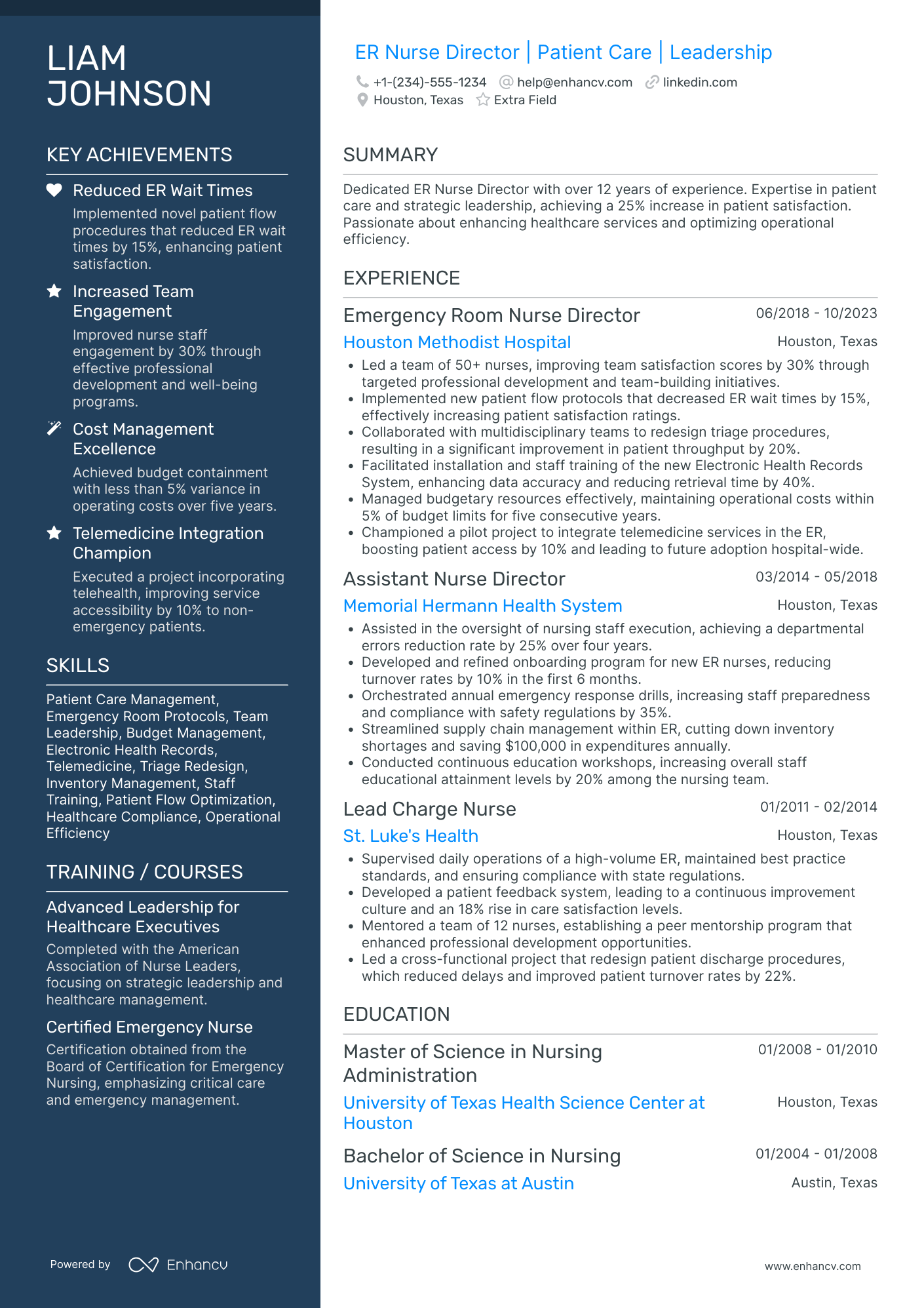Emergency room nurses keep a cool head while triaging critical cases, provide calm, compassionate support to patients and families, maintain detailed and accurate records, and facilitate communication of vital information between patients, families, and care teams. And they do all of this while performing clinical nursing duties.
Boiling down the extensive knowledge, multifaceted skills, and hands-on experiences in fast-paced environments required of an ER nurse within a resume's limited space can seem impossible.
The key to writing an excellent ER nurse resume is approaching it methodically, as you would an overwhelming ER shift.
This resume guide, including examples and pro tips, addresses many common resume writing challenges ER nurses encounter and offers a straightforward step-by-step approach to overcoming them.
See the guides below for additional resources and examples for related nursing specializations and medical professions.
ER nurse resume example
Here’s what this applicant does well in their resume:
- Highlighting Relevant Certifications and Courses: The inclusion of the Certified Emergency Nurse (CEN) certification and Advanced Trauma Nursing Course directly aligns with the specialized skills required for an ER nurse, showcasing the applicant's commitment to ongoing professional development in emergency care.
- Quantifiable Achievements in Experience: The resume effectively uses numbers and specific results in the experience section, such as "reducing patient transfer times by 25%" and "improving patient survival rates." This approach demonstrates the applicant's impact in previous roles and their ability to handle the demands of an ER environment.
- Leadership and Training Skills: By mentioning leadership roles like leading a team of nurses and training new staff, the applicant shows they possess essential soft skills for the ER nurse role, which often requires teamwork, mentorship, and the ability to manage stressful situations.
- Tailored Summary Section: The summary is concise and tailored to the ER nurse role, highlighting over 7 years of experience, specific skills like triage and critical care, and a significant career achievement. This provides a strong introduction that aligns with the job requirements.
How to format an ER nurse resume
While nurses are always in demand, specialized nursing positions can be competitive. Utilizing every aspect of your ER nurse resume, including formatting, for optimal impact is an excellent way to ensure your resume stands out among other applicants.
Formatting is an opportunity to guarantee your qualifications stand out to employers and make an excellent first impression. To create an ER nurse resume that's well-organized, professional, and memorable, consider the following best practices:
- Creative Elements - Include creative elements like colors and decorative patterns to make your resume unique and memorable.
- Header Content - A prominent header featuring your name, desired job title, and contact information lets employers know who you are at a glance.
- Ordering - Listing all section examples in reverse chronological order ensures your most recent and, therefore, relevant certifications and experiences appear first.
Understanding the role of Applicant Tracking Systems (ATS) is critical when formatting your ER nurse resume. ATS analyzes text on resumes, looking for precise keywords or phrases corresponding to desirable skills and qualifications for a particular position. Employers use these systems to quickly sort and prioritize resumes to view the most qualified candidates. ATS-optimized formatting facilitates ATS's ability to recognize and parse information from your resume accurately.
Here's what's considered "best practices" for ATS-optimized formatting on your resume:
- Fonts - Select ATS-friendly fonts matching the overall style of your resume. Some ATS-friendly fonts are Calibri, Arial, and Times New Roman. However, by employing these overused fonts, you may miss a chance to make your resume stand out. For interesting, modern font options with excellent readability, try Rubik, Lato, Montserrat, Raleway, Exo 2, or Volkhov, all available on the Enhancv Resume Builder.
- Document Type - Doc or PDF files are typical for resumes and most easily analyzed by ATS.
- Creative Elements in Text - Avoid using nonessential stylistic features within text. Elements such as emojis and non-standard date formats can impede ATS’s ability to recognize information in these sections.
- Headings and Subheadings - Ensure resume sections are logically organized and include simple, precise headings. Standard section titles ensure ATS accurately recognizes and extracts information from these sections.
Consider your target market – resumes in Canada, for example, follow different layout conventions.
Is your resume good enough?
Drop your resume here or choose a file. PDF & DOCX only. Max 2MB file size.
To improve the organization and ATS optimization of your resume, include the following top-recommended sections for ER nurses.
The top sections on an ER nurse resume:
- Contact Information: Essential for the recruiter to know who you are and how to contact you.
- Professional Summary: To provide a brief and concise overview of your qualifications, skills, and experience in emergency nursing.
- ER Nursing Skills: Highlighting these would underline your capabilities and experience in handling emergency situations, essential for an ER nurse.
- Experience in ER Nursing: This displays your practical knowledge and previous involvement in emergency medical contexts.
- Certifications and Training: Displaying these would validate your abilities and indicate that you are up-to-date with current ER procedures and best practices.
Recruiters specifically seek out ER nurses with particular in-demand skills and abilities. Include the following qualifications within your resume sections to ensure your resume gets noticed:
What recruiters want to see on your resume:
- Relevant ER Experience: This is prioritized due to the high-stress, quick decision-making nature of ER nursing. Recruiters need to know you can handle the pressure and respond effectively.
- Certifications and Licenses: These are non-negotiables in nursing roles. They signify your adherence to industry standards and legal regulations.
- Specialized Skills: These help recruiters ascertain your ability to perform specific ER tasks such as administering medication, performing resuscitation procedures, and wound management.
- Patient Care and Bedside Manner: Due to the intensity of ER environments, having exceptional interpersonal skills and a compassionate approach to patient care are highly prioritized.
- Continual Professional Development Evidence: ER nursing methods frequently change with emerging research and technology; recruiters look for candidates who stay updated in their knowledge and skills.
How to write your ER nurse resume experience
ER nurses require specialized skills and knowledge for working in fast-paced, high-pressure environments. The most effective way to demonstrate these skills is to showcase prior experiences, successfully navigating these environments, and making achievements.
The experience section of your ER nurse resume allows you to share valuable clinical experiences that illustrate the emergency nursing abilities and achievements you developed in these positions.
Your descriptions of these experiences must go beyond detailing duties you performed to highlight specific skills and accomplishments to showcase not only what you did but how well you did it.
Take a look at the following experience examples to better understand how quality descriptions strengthen your resume's experience section.
- •Provided compassionate care to patients in a high-volume Level II Trauma Center.
- •Conducted assessments of patient conditions, including triaging patients based on the severity of the condition.
- •Participated in a new protocol for managing sepsis patients, contributing to a reduction in mortality rates.
- •Contributed to patient care and teamwork in the emergency department.
This experience example describes skills and experiences pertinent to emergency nursing. However, it could be more effective by providing specific details such as keywords and quantitative data evidencing their impact in this role. The result is an overly general explanation that fails to leave a lasting impression.
- •Provided high-quality, compassionate care to patients in a high-volume Level II Trauma Center, handling over 80 patients per shift in a fast-paced environment.
- •Conducted thorough assessments of patient conditions, including triaging patients based on the severity of the condition, which led to a 15% improvement in patient flow efficiency.
- •Played a key role in a task force that implemented a new protocol for managing sepsis patients, contributing to a 20% reduction in mortality rates within the first year of implementation.
- •Received the Nurse of the Year award in 2020 for exceptional patient care, teamwork, and leadership in the emergency department.
This improved experience example incorporates percentages demonstrating this nurse's effectiveness in this role. They also utilize keywords like ¨fast paced¨ and ¨efficiency¨ by adding detail to their descriptions. Finally, they evidence the quality of their work by including their Nurse of the Year award.
When selecting experiences to include on your ER nurse resume, creating a targeted experience section is best. A targeted experience section only includes work experiences demonstrating the most desirable skills aligned to an available ER nurse position.
PRO TIP
To quickly and easily create a targeted ER nurse resume for individual applications, follow these steps:
- Create a resume template including a complete list of your experiences, certifications, education, and skills.
- Make a copy of the template for each new application.
- Review the job description for each new job you apply to, paying close attention to ideal candidate descriptions.
- In the copy of the template, delete all examples that don't align with the job description.
- Edit remaining examples to ensure they include keywords copied directly from the job description for increased ATS optimization.
How to quantify impact on your resume
To boost the impact of your ER nurse resume, include quantifiable evidence of your skills in experience descriptions. These are tangible, measurable, or verifiable details that highlight your accomplishments in past jobs, illustrating your abilities for employers.
The example above provides several excellent examples of using numbers and percentages to bolster descriptions. For example, stating the average number of patients treated daily quantifies the applicant's perception of a "fast-paced" environment.
Many other ways exist to quantify experiences on an ER nurse's resume. Here are a few additional options:
- Percentages indicating improvements in patient satisfaction scores showcase your commitment to patient care.
- The volume of trauma cases you've dealt with illustrates your expertise and experience in managing emergencies.
- The size of the team you've worked with or led reflects your teamwork and leadership skills.
- Reduced treatment waiting times under your purview indicate your efficiency and management abilities.
- How many years worked as an ER nurse demonstrates your commitment to the specialized field.
- Quantifiable results from initiatives you've implemented show your ability to drive change and improvement.
- The number of hospital departments you've coordinated with underscores your collaborative abilities in complex organizational structures.
How do I write an ER nurse resume with no experience
The experience and certification requirements required to become an ER nurse mean that writing a resume without prior employment in the specialization shouldn’t be overly challenging.
The key to writing an experience section without ER nursing experience is to select closely related nursing jobs that showcase highly transferable skills—for example, experience in fast-paced medical environments or working with patients in high-stress situations.
To write a nurse resume that establishes your potential to succeed as an ER nurse without experience, follow these steps:
- Compile a list of keywords from the job description.
- Brainstorm previous positions, such as general nursing and practical clinical experiences, internships, and volunteer experiences showcasing the same keyword skills and knowledge from your list.
- Utilize the keywords from the job description in your transferable experience descriptions.
- Avoid including irrelevant work experiences.
- Add credibility by including tangible evidence of transferable skills, such as certifications and quantifiable data.
- List experiences in reverse chronological order to ensure your most recent and relevant examples appear first.
How to list your hard skills and soft skills on your resume
“Diverse” doesn’t seem to be a strong enough adjective to describe the skill set necessary for emergency nursing. Besides standard nursing skills such as medical expertise, effective communication, and the ability to perform clinical tasks, ER nurses need physical stamina, quick decision-making under pressure, and unparalleled patience and empathy.
Your skills section requires a blend of hard and soft skills to provide employers with an accurate understanding of your abilities.
Hard skills are the technical skills that require study, training, and practice. In nursing, these skills typically require certifications, such as CPR and triaging critical patients.
Reference the list below list for the most in-demand hard skills to include on your ER nurse resume:
Best hard skills for your ER nurse resume
- Triage Skills
- Emergency Response
- Cardiopulmonary Resuscitation (CPR)
- Critical Care Nursing
- Telemetry
- Wound Dressing
- Intravenous Therapy
- Medication Administration
- Patient Assessment
- Electronic Health Records (EHR)
- Life Support Systems Operation
- Cardiac Life Support
- Automated External Defibrillator (AED) Usage
- Blood Draws
- Pain Management
- Use of Emergency Medical Equipment
- Knowledge of Intubation Procedures
- Proficiency in using ventilation equipment
- Operating Resuscitation Equipment
- Surgical Assisting Skills
On the other hand, soft skills are some of the most highly valued skills in nursing. These intrinsic or personal skills demonstrate your ability to provide excellent patient care and think clearly in high-stress conditions. In ER nursing, these are skills such as attention to detail, emotional intelligence, and compassion.
As an ER nurse, these skills don’t just involve treating patients with kindness and empathy. Abilities like quick decision-making and crisis management could mean the difference between life and death.
Employers may be willing to train applicants in hard skills. However, the intrinsic nature of soft skills makes them challenging to teach and, therefore, immensely valuable. Including as many relevant, transferable soft skills as possible on your nurse resume is essential to establish overall nursing competence.
Use this list of the top soft skills for ER nurses to cultivate a comprehensive and compelling skills section:
Best soft skills for your ER nurse resume
- Stress Management
- Work Under Pressure
- Emotional Intelligence
- Teamwork
- Compassion
- Patience
- Crisis Management
- Excellent Communication
- Quick Decision Making
- Cultural Competence
- Resilience
- Adaptability
- Leadership
- Empathy
- Sensitivity
- Conflict Resolution
- Multi-Tasking
- Problem-Solving
- Detail Oriented
- Active Listening
- Time Management
Selecting which skills to include on your resume without overwhelming the hiring managers can present a challenge. Follow these steps to create a logically organized skills section that shares your most valuable skills:
- Format your skills section as a simple list without elaboration or examples.
- Differentiate between hard and soft skills by listing them in separate subsections.
- Target your skills section using keyword skills from the job description.
- Write these keyword skills precisely as they appear in the job description to enhance ATS analysis.
- Never lie about or exaggerate your skills on your resume.
- Ensure consistency between your experience and skills sections by listing the skills mentioned in the experience section in the skills section and vice versa.
Pro tip
Nursing terminology on your resume
Including medical terminologies demonstrates experience in and familiarity with the field. However, excessive jargon or abbreviations can confuse hiring managers who might not have a nursing background. Therefore, you must balance nursing lingo and generally understood terms on your resume.
How to list your certifications and education on your resume
Education and certifications are essential for all nurses. However, ER nurses require additional qualifications to demonstrate their foundational knowledge and specialized skills in critical care. For example, while all registered nurses must obtain a nursing degree from an accredited nursing program, such as an Associate Degree in Nursing (ADN) or a Bachelor of Science in Nursing (BSN), many healthcare facilities prefer or require a BSN for ER nursing positions due to the complexity of the role.
Your resume's education section must include all standard nursing education as well as education and certifications specific to emergency nursing.
Follow these steps to write ATS-optimized certification and education sections:
- Create separate sections titled "Education" and "Certifications" to allow ATS to parse information from your resume accurately.
- List all degrees and certifications chronologically, putting your most recent and relevant at the top.
To craft a powerful education section on your ER nurse resume, follow these guidelines:
- For each degree, include the name of the institution, its' location, the dates attended, and the title of your degree.
- Continuing education courses required for maintaining your nursing license can be listed in the education section. However, if the section is excessively long, you can create a separate "Ongoing Education and Training" section, described below in "Additional sections for an ER nurse resume."
- Including your GPA is optional unless the job description specifies a minimum requirement.
Here's an example of an excellent education section on an ER nurse's resume:
Your Certified Emergency Nurse (CEN) credentials are, of course, the most essential feature of your ER nurse certifications section. Nevertheless, you can utilize this section to highlight numerous other specialized skills and knowledge relevant to ER nursing, such as advanced life support certifications.
These best practices will help you create a thorough and professional certification section:
- Include the name of the certification, the certifying institution, and the year obtained.
- Limit your certifications to those specifically named or directly related to the required skills mentioned in the job description.
- Limit certifications to current, unexpired credentials.
- If a certification requires renewal to remain valid, include the date first acquired as well as the most recent renewal date or a "valid through" date. For certifications you have held long-term, this demonstrates soft skills such as organization and responsibility.
The following are some of the most highly sought-after certifications for nurses and should be included on your resume whenever relevant.
Best certifications for your ER nurse resume
Bogging down your resume with too many education and certification items can make it difficult for recruiters to recognize your most valuable qualifications. To prevent this, you should tailor these sections for each application by sharing only examples that are well aligned to the position to reinforce your targeted skills.
How to write your ER nurse resume summary or objective
A resume objective or summary statement is an effective tool for contextualizing the facts and data found in your ER nurse resume. These personal statements aim to construct a concise narrative clarifying your nursing experience, career trajectory, and future goals.
A summary statement focuses on your past nursing experiences to demonstrate a substantial background of transferable skills and knowledge. In contrast, an objective statement describes future career goals to illustrate how they correspond with the job opportunity.
Follow these best practices when writing either a resume summary or an objective:
- Tailor the statement to the specific ER nurse job you're applying for by emphasizing keyword skills and experiences from the job description.
- Start sentences with action verbs to make your summary dynamic and impactful.
- Be brief. A summary should only be 3-5 sentences.
A summary is preferable for nurses with extensive experience in emergency medicine or similar medical specialties. It highlights past successes to indicate your potential to be successful in the available job.
When writing a summary for your ER nurse resume, follow these best practices:
- Highlight your emergency nursing skills and experiences using keywords from the job description to make your summary more impactful.
- Briefly mention years of emergency medicine experience to evidence your expertise level.
- Use details such as names of specific medical software, equipment, procedures, and certifications to reinforce your stated skills and experiences.
- Convey your enthusiasm for the opportunity to continue providing high-quality patient care in the medical field in this position.
A common mistake on ER nurse resumes is to be too generic and not specifically target your statement for an emergency nursing position. Check out how the following summary is enhanced by targeting it for a career in emergency medicine.
This applicant clearly demonstrates they possess nursing knowledge, experience, and skills. However, the information provided fails to highlight qualifications specific to emergency nursing. A generic resume may fail to grab the attention of hiring managers and stand out among numerous applicants.
This summary is improved by incorporating highly valued qualifications specific to ER nursing. By mentioning their critical care nursing certifications, hard and soft skills such as triaging patients and communicating in critical care situations, and work experience in fast-paced emergency medicine environments, this applicant’s summary can more effectively attract the attention of employers looking for an experienced ER nurse.
An objective statement is better suited for nurses with limited or no experience in an emergency care facility. It allows you to focus on how you plan to use your related background knowledge and experiences to achieve career goals while contributing to the success of the medical facility.
To write your ER nurse resume objective, follow these best practices:
- Describe the type of position you are seeking.
- Share relevant or transferable skills that will help you succeed in the position using keywords directly from the job description.
- Clearly state your career goals and enthusiasm to work towards them in the role.
- Highlight valuable contributions you can make while learning and gaining experience.
- Avoid generic phrases. Instead, focus on specific skills and goals that set you apart.
PRO TIP
Rephrasing specifics from the “Qualifications” or “Ideal Candidate” sections of a job description is a great way to guarantee you mention the skills and qualifications most valued by the employer.
Optimize your resume summary and objective for ATS
Drop your resume here or choose a file.
PDF & DOCX only. Max 2MB file size.
Additional sections for an ER nurse resume
Once you’ve written the top-resume sections for ER nurses, including one or more of these additional resume sections can highlight particular qualifications or accomplishments and help you stand out among numerous other applicants.
- Languages: Excellent patient communication is a cornerstone of the healthcare industry. Therefore, being multilingual is a valuable asset in nursing. Including a language section is an effective way to set yourself apart from other applicants.
- Volunteer Experience: Include healthcare-related volunteer work or community service to demonstrate a commitment to giving back and supporting the community.
- Leadership Experience: To demonstrate extensive experience leading teams and initiatives, share your past leadership roles, such as charge nurse, preceptor, or committee member.
- Achievements and Awards: If you’ve received recognition during your nursing education or career, consider including an awards and achievements section to support your stated skills. In addition to individual awards, you can include awards your office or team received, such as being voted the top healthcare facility in your community.
- Passion: If you have a personal experience that drives and motivates you as an ER nurse, sharing a short statement establishes your passion for and dedication to nursing excellence and personalizes your resume. For example, an experience in the Emergency Room as a child when a nurse was exceptionally kind and eased your fears, inspiring you to specialize in emergency medicine to provide the same level of care to others for others.
- Professional Associations: Professional Association memberships highlight your dedication to ongoing improvement and staying current in dentistry. If you’d like to include a professional association membership to your resume, consider joining one of the leading professional associations for nurses below.
Professional associations for nurses:
These prominent professional associations for nurses provide resources, support, and opportunities for networking and continuing education:
General Nursing Associations
Including training and ongoing education on your ER nurse resume
Including a curated list of training and workshops you’ve completed specifically applicable to ER nursing can be impactful. They demonstrate up-to-date knowledge and skills and a commitment to the specialized field of ER nursing.
To include ongoing education and training on your ER nurse resume, follow these steps:
- Create a simple ATS-friendly title for the section.
- Target your list to include only recent training or courses directly related to emergency care.
- List items in reverse chronological order to ensure the most recent appears at the top.
- Include the date completed and a brief description of the content covered.
- Use keywords from the job description when describing information and skills covered in the sessions.
- Detail any technical skills developed during training sessions, such as using emergency equipment and software, including defibrillators, cardiac monitors, and infusion pumps.
Here is an example of how a Training and Continuing Education Section should look on your ER nurse resume:
Key takeaways
Creating your ER nurse resume is the first step towards acquiring a rewarding position supporting patients in their hour of need. Keep these vital key takeaways in mind to ensure your resume makes a lasting impression on hiring managers:
- Organization is a critical component of your resume formatting, enabling employers and ATS to quickly and easily identify your skills, experience, and other qualifications.
- A targeted experience section ensures your most relevant and transferable skills stand out to hiring managers.
- To develop a full understanding of diverse skills, create a targeted list of skills that includes subsections for hard and soft skills.
- Keep your resume summary or objective specific to ER nursing skills and experiences to showcase expertise in the specialization.
- Include an ongoing education and training section to highlight your dedication to staying current in the field of emergency medicine.
- Providing quantifiable evidence of achievements in your nursing experience descriptions demonstrates your impact in past roles.
- Give context to the information on your resume by including either a summary or an objective section, depending on your experience in similar nursing positions.
ER Nurse resume examples
By Experience
By Role
